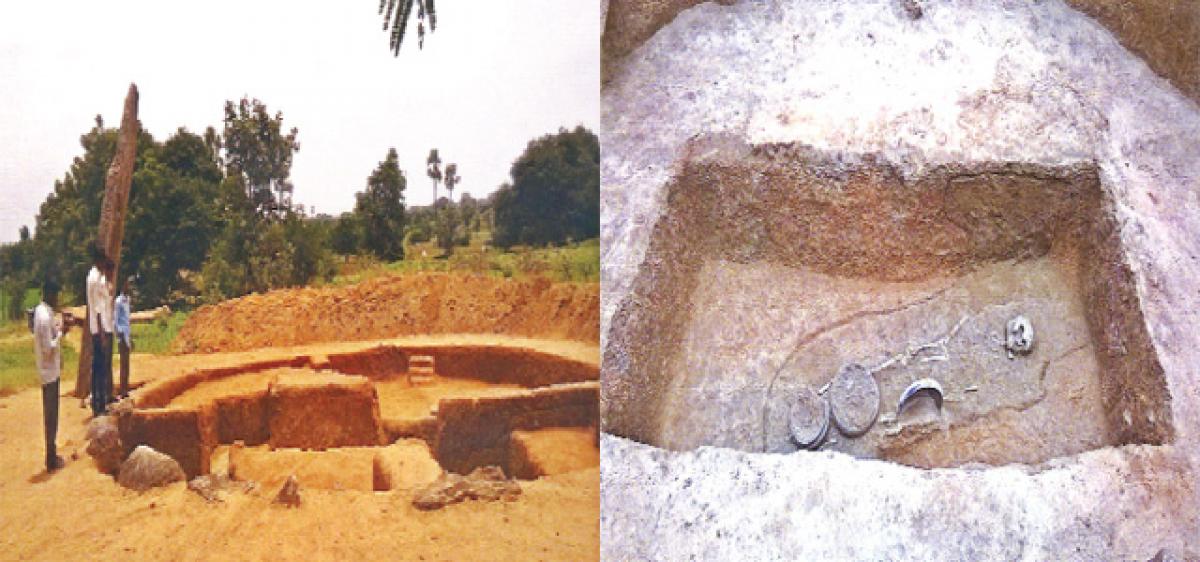Live
- Gahlot resignation: Delhi Congress calls AAP a sinking ship
- Consultative body on doctors' walkout fails to narrow differences in South Korea
- Honouring bravehearts: Army commemorates Nuranang Day
- 40,000 aspirants participate in army recruitment rallies across Jammu division
- Nigerian President Tinubu lauds PM Modi's efforts to amplify concerns of Global South
- Congress in Himachal to hold event in Bilaspur to mark two years at helm
- Hitaashee takes third title of the season, wins 14th leg of WPGT
- Group-3 exams in Wanaparthy district peacefully*
- Shraddha Das reigns as a fashion icon
- ‘Sarangapani Jathakam’ teaser set for Nov 21st release
Just In

In what can be termed as a major breakthrough in exploring India’s megalithic culture, the Telangana Department of Archaeology and Museums and the Centre for Cellular and Molecular Biology (CCMB) have cracked the centuries old question of who were the original inhabitants of the land or human groups which migrated outside India.
Hyderabad: In what can be termed as a major breakthrough in exploring India’s megalithic culture, the Telangana Department of Archaeology and Museums and the Centre for Cellular and Molecular Biology (CCMB) have cracked the centuries old question of who were the original inhabitants of the land or human groups which migrated outside India.
“It is for the first time that we can say that there is connection between West Asia and North West India and Deccan region. It can now be established genetically,” said N R Visalatchy, director of Telangana Department of Archaeology and Museums.
HIGHLIGHTS:
- With the retrieval of DNA from ancient skeletal remains, experts for the first time establish genetic descendants from West Asia
- The excavations spread across 50 burials in at Pullur village in Medak district and Siddipet show similarities with mutations in West Asia
- Reverse migration from Telangana to West Asia, especially to Iran, took place
She was speaking at the international seminar on recent trends in Archaeology, Art History and Conservation in Telangana here on Monday.
There is a clear case for land migration as against sea route. The period these people lived in was between 600 BC and 500 BC and belonged to West Asia.
The findings were possible after the excavations taken up by the Department of Archaeology at Megalithic monuments of Pullur in Medak district and Khammam.
The recent genetic analysis approach as well as radio carbon dating methods were applied on the bone relics recovered from the excavations.
Speaking to The Hans India, Niraj Rai, scientist from CCMB, who took part in the project said, “The idea is to trace the genetic makeup of megalithic people.
Who were they? From which part of the world they arrived and also find out the health implications of people of those times. We are trying to see if they had a diabetic gene? Did they suffer from other health issues such as heart ailments as well?”
“For the first time we can say that there is connection between West Asia and North West India and Deccan region. It can now be established genetically. Further studies with CCMB will also be able to prove the collapse of Harappan civilisation.”
-N R Visalatchy, director of Telangana Department of Archaeology and Museums Out of the 12 samples, CCMB has just worked on three and there are umpteen possibilities.
As of now though it is established that there is indeed a connection with West Asia especially from Iran, Visalatchy said that there is also a possibility of reverse migration as well as genetic strains of M30 Haplogroup (A set of mutations define the maternal ancestry) is found in Palestinians.
There is a reverse flow from India into that region. Now M30 is present in modern population in North India.
It threw a lot of questions such as what were the religious beliefs of megalithic people. How was their society organised and where do they fit into the historical narrative of Indian sub-continent.
Niraj Rai said, “There is possibility that people from Telangana going to West Asia as M 30 and M 4 mutation provided evidence. M30 haplogroup is found in Palestinians there is a reverse flow from India into that region.
It threw a lot of questions. Now M30 is present in modern population in North India” There are many similarities that include the location of burials with preference to safeguard agri-land and pastures, preference to cardinal directions; funerary objects include iron, horse skulls and horse bones.
Several questions, such as were they horse breeders, arose. Out of the one per cent of the objects found, 25 to 25 per cent were of tin. The practise of cremation also found to be secondary burials with cup marks but a few cremations were also found.

© 2024 Hyderabad Media House Limited/The Hans India. All rights reserved. Powered by hocalwire.com







